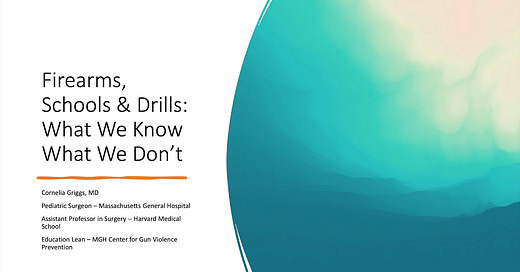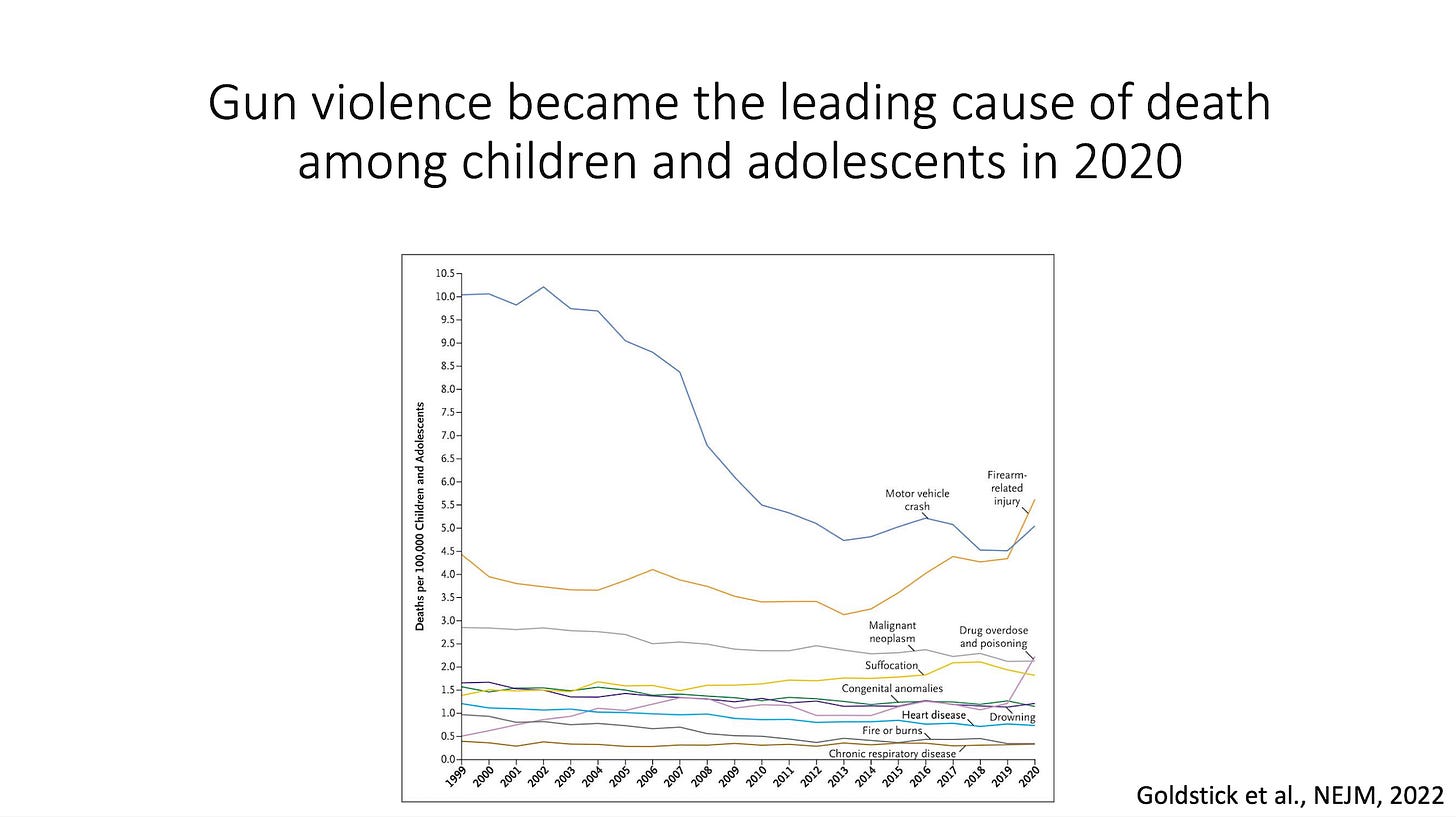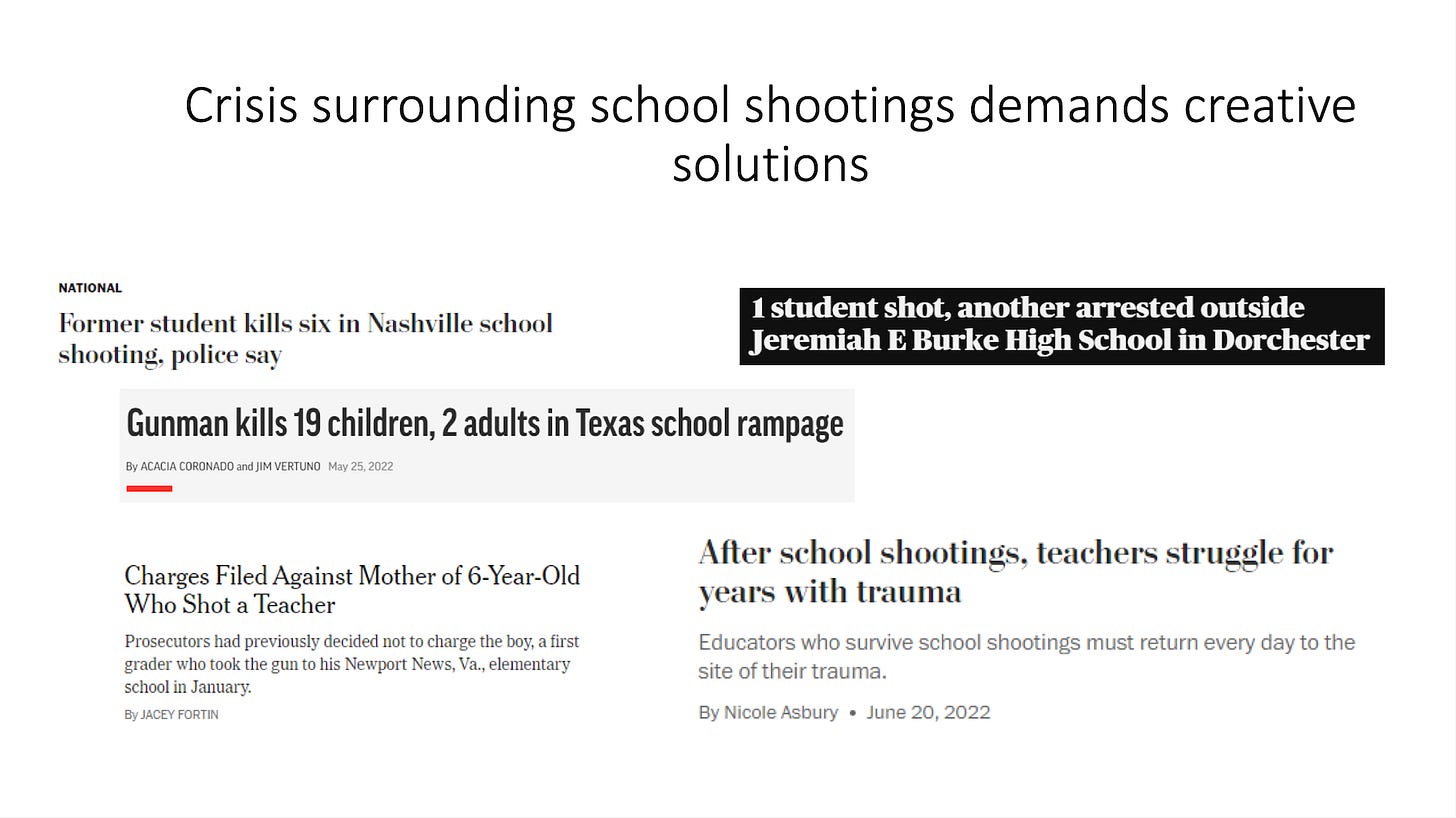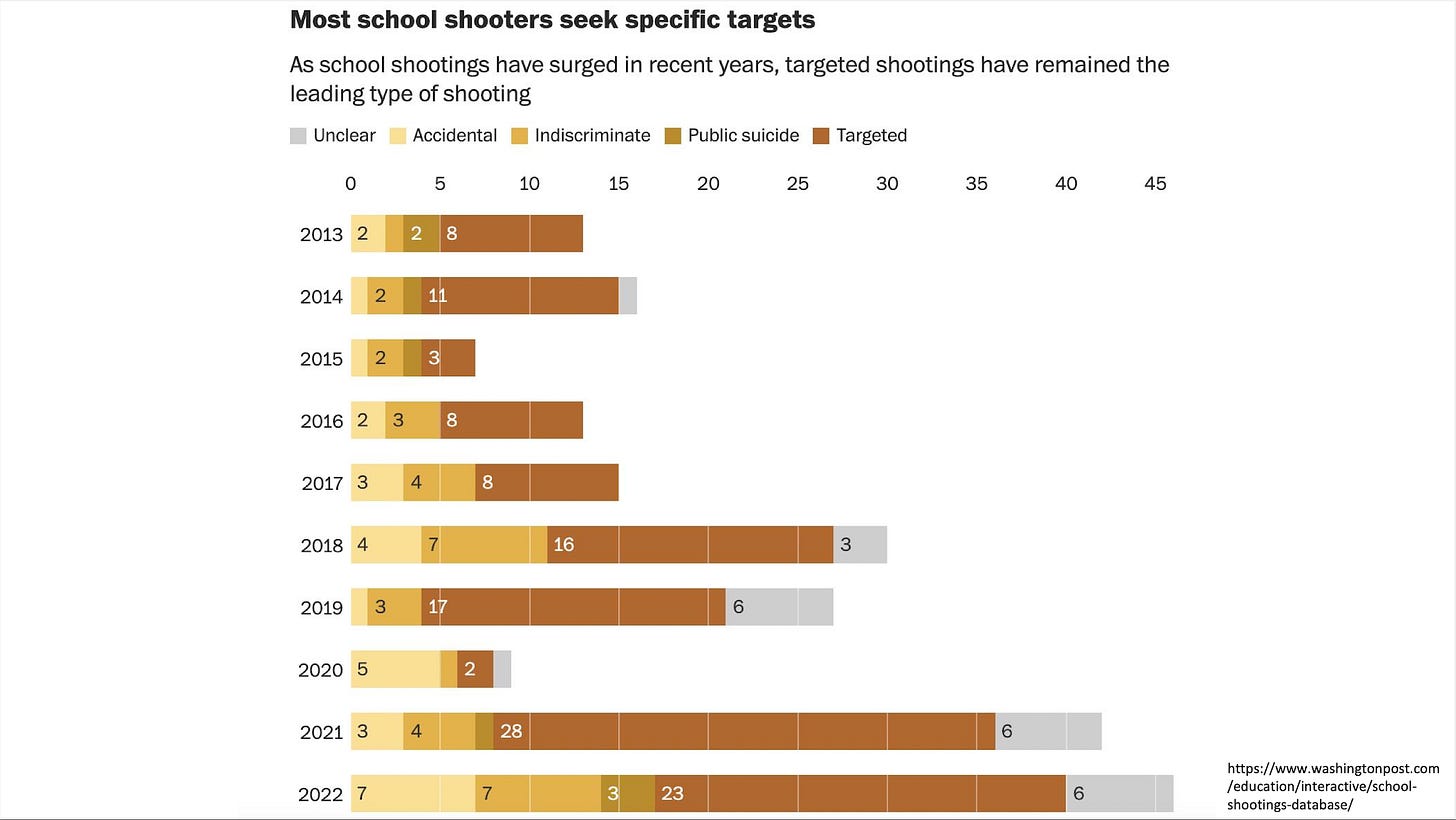Firearms, Schools & Drills - What We Know, What We Don't
"Do the unproven benefits of these drills outweigh their known collateral consequences to school communities' mental health and wellbeing?" asks Dr. Cornelia Griggs.
The House Special Legislative Study Commission to Evaluate and Provide Recommendations on Mandated Safety Protocols for Rhode Island Schools met on Wednesday and heard from Dr. Cornelia Griggs, a pediatric surgeon at Massachusetts General Hospital, an assistant professor in surgery at Harvard Medical School, a trauma and critical care specialist, and an injury prevention researcher.
The Commission is tasked with determining what changes, if any, need to be made to Rhode Island General Law 16:21:4 in light of the national landscape of school shootings and the recent swatting events that affected many districts in our state. Of particular interest is the psychological and emotional impacts of school shooting drills, that is, lock-down rehearsals conducted at schools throughout Rhode Island to prepare the students and staff for the possibility of an active shooter. I covered the first meeting of the commission here.
Key takeaways from Dr. Grigg’s presentation:
Children of color are far more likely to experience campus gun violence about two times as much for Hispanic students and about three times as much for black students.
The total number of children exposed to gun violence at school has exploded from about 187,000 in 2018 to over 330,00
95% of American public schools have lockdown drills or procedures, but there's almost no research affirming the value of these drills for either prevention or protection
The overwhelming number of school shootings are committed by a current or former student at the school.
drills should not mimic an actual incident or be hyperrealistic
There is no existing validated curriculum for school nurses to develop comfort around gun violence prevention efforts
Existing research supports access to mental health professionals and social support, non-punitive and non-exclusionary disciplinary processes, trauma-informed emergency planning, robust crisis intervention teams, and education on gun locks, and safe storage for firearm owners.
Here is Dr. Grigg’s presentation, with her comments, edited for clarity:
Dr. Cornelia Griggs: This is an off-quoted statistic and one that I hate to repeat, but I put it at the beginning of almost every presentation. Gun violence sadly became the leading cause of death among children and adolescents in the United States as of 2020. You can see on the graph where the orange line passes the blue line. That's the point at which firearm injuries surpassed motor vehicle collisions as the number one cause of death for our nation's children.
Dr. Cornelia Griggs: The crisis surrounding school shootings demands creative solutions. I'm going to ask all of you here today to think somewhat creatively with me as I go through some of the research about what we know and what we don't know about school shootings and specifically lockdown drills.
School Shootings: What We Know
Dr. Cornelia Griggs: There have been 389 school shootings since Columbine. School shootings disproportionately affect Black children. Almost all of the deadliest assaults have involved white gunmen, giving a false impression that shootings exclusively affect white children, but children of color are far more likely to experience campus gun violence - about two times as much for Hispanic students and about three times as much for Black students. The median age of a school shooter is 16, implying that children have access to firearms. We know that about four and a half million children nationwide are living in homes with unlocked and loaded guns and that school shootings have been on the rise, dramatically so, since 2018.
A particularly disturbing statistic for me, as a parent in 2023, is a snapshot of children at risk. You can see by the steep rise on this bar graph that unfortunately we are on track to surpass the 2022 record for the number of school gun incidents by early November of this year. The source for this is the K through 12 school shooting database, which is maintained by my colleague and collaborator, David Ryman, a security specialist who used to work for the Department of Homeland Security and now is a gun violence researcher who maintains this database.
Dr. Cornelia Griggs: The total number of children exposed to gun violence at school has exploded from about 187,000 in 2018 to over 330,000 [today], and we can see from this bar graph some of the most widely publicized and deadly school shootings in the past year. You can see the increasing frequency of those most deadly attacks as well.
Dr. Cornelia Griggs: Most school shooters are seeking specific targets. This bar graph is taken from an analysis done by the Washington Post where you can see this kind of brown-orange number representing school shootings that involved a targeted attack.
Drills
Dr. Cornelia Griggs: Drills are nothing new. Since World War I schools have been holding safety drills, whether those be fire drills, natural disaster drills, or even nuclear drills, but modern active shooter drills can expose students and staff to frighteningly realistic scenarios. What's different is that for students today, the threat is not theoretical. Students have seen and heard about children just like them who were shot dead in classrooms just like theirs and often witnessed it over social media.
95% of American public schools have lockdown drills or procedures, but there's almost no research affirming the value of these drills for either prevention or protection and the impact of hyperrealistic drills where actors simulate an armed gunman entering a school, often recreating the sound of shots being fired. These drills and their value must be reconsidered. While only 0.2% of gun deaths a year occur on school grounds, drills to prepare students and staff have become a near-universal practice. I'm here to ask you today to consider whether these drills harm students more than they help. The answer to this question demands more research. I won't pretend to have all the answers today, but I will present some of what we know through our research.
What is the cost of these drills?
Dr. Cornelia Griggs: 10 months after the Parkland shooting in Florida, at Lake Brantley High about 200 miles north of that school, a code red emergency was called over the intercom, suggesting that over 2,700 students were in immediate danger. “Active shooter reported at Brantley,” read a text sent to teachers, “Initiate a code red lockdown.” Students wept, had asthma attacks, and messaged parents to say goodbye. This was all in the setting of a drill. The drill was kept secret so people would take it seriously, a spokesman later argued, insisting that it was the only way to get their attention.
False Narrative, Flawed Logic
Dr. Cornelia Griggs: I have concerns that these drills are being held under a false narrative fueled by flawed logic. Drills have been built around a narrative of a deranged outsider trying to get into every classroom to kill as many students as possible. This narrative was built out of the tragic shooting at Sandy Hook. I know that may have affected some of you in the room, but that was a very uncommon circumstance. In every single other public space, whether it's a shooting, a fire, a gas leak, or a train crash, we tell people to get away from the threat by every means possible.
But without any evidence to drive the procedure, students are being told to sit quietly in their classrooms. The overwhelming number of school shootings are committed by a current or former student at the school. They know the plan when a drill is being held. They know the layout of the school. They know the intricacies of which doors are left locked or unlocked, sometimes accidentally, and we saw this play out horrifically at the school shooting in Uvalde, Texas.
Drills might be necessary
Dr. Cornelia Griggs: I'm not here to condemn them necessarily, but I'm asking everyone in this room to consider that existing drills do not consider students' ages and developmental stages. What we know from our research is that many, young children especially, walk away from these drills not knowing that they were drills. They go home under the impression that there was an armed intruder in their school that day. In many of these drills and procedures, there's no recourse for students who don’t have the ability to leave a classroom easily or have learning challenges.
I have concerns that these are largely reactive measures and are not taking into consideration the need for preventative programs to create a culture of safety in schools. Investing in a multi-strategy, multidisciplinary health-based approach that takes into consideration student and faculty development and mental and emotional health is essential. The goal of these drills, or any preventative measures, should be to transform fear into courage and anticipation into action by implementing student-focused strategies that are rooted in prevention.
Drill Guidelines
Dr. Cornelia Griggs: These drills should not mimic an actual incident or be hyperrealistic. We know from students and faculty members who have been in the building during these hyperrealistic drills that the effects are traumatic and there is a significant mental health burden associated with experiencing them. Our schools and administrators should provide advanced notice when a drill is planned, and school personnel should help create appropriate drill content that involves trauma-informed approaches to address student well-being.
Unheard Voices: School Nurses
Dr. Cornelia Griggs: An important part of my research centers around the voices of school nurses, and I want to give some credit to my partner in this research, Robin Cogan, who has been a long-time gun violence prevention advocate and school safety advocate amid the national crisis around school shootings. There's increasing demand for partnerships with gun violence prevention programs in schools. Our Gun Violence Prevention Center at Massachusetts General Hospital developed and launched novel gun violence prevention for school nurses.
There is no existing validated curriculum for school nurses to develop comfort around gun violence prevention efforts, but school nurses are essential to maintaining a safe and supportive environment for students. School nurses are our colleagues in healthcare, and they may be uniquely poised to identify at-risk students. As such, school nurses should be educated on how to ask about gun presence, gun safety, and conditions when red flag measures should be considered.
As a first step of our pilot in developing this curriculum, we held two large focus groups with a nationally representative sample of school nurses from around the country. As healthcare providers working within schools, which serve as major hubs and pillars of community standards, school nurses are well-positioned to champion cultural change around the topic of gun violence and prevention.
Themes: lack of support & resources
Dr. Cornelia Griggs: Bear with me while I read from some quotes from those focus groups, but one of the major themes was a lack of support and resources in our schools. This is a quote from one of the nurses who participated:
“And so, although my heart is very much into wanting to make these systemic changes, just you know my day is crowded with, you know, important issues. But I just find a hard time kind of dividing up my time to be able to focus on some of these bigger issues. I feel like I'm putting fires out all day, and that doesn't even really touch on the gun violence issue. That's just looking at some of the bigger, just health and safety issues that are also important. So for me, I feel like I'm two steps behind because I'm just feeling like I need to advocate for better understanding - what a school nurse is, and what our education and our skills are, and how we are best utilized."
Theme: Mental health crisis & culture of fear
“I feel like post-COVID, with the parents, with the staff, there's still a lot of anxiety. People get angry quite quickly. And sometimes you just don't know the right questions to ask to deescalate things or to find out more about a child's family life without insulting or upsetting someone in the process.”
“We're afraid. Our safety is a concern. The mental health of our students and our staff is I think worse than I've ever seen it. Those YRBS reports - well before COVID were already trending in the wrong direction and everything in the pandemic just kind of compounded it. And we need a path, we need a road to get into those. If we're all not ok, none of us are going to be ok.”
Theme: Unstable environment
"I know from my vantage point, we are seeing concerning behaviors of children, and truthfully, of staff. We have dysregulated people in our world at the moment. And so they're not helpful to children if a dysregulated staff member cannot necessarily help a dysregulated child. And we see a huge access to weapons that are being brought to school. So these are the concerns.”
"I was a building nurse and now I'm a district nurse. I go building to building now. I gave up my office because I didn't feel safe. You gotta protect yourself, you gotta protect yourself.”
Theme: Firearms & Safety
“I think a tool that's missing from my belt is really how to quickly assess and ask that question and normalize it... how to have a conversation about guns in the home. Almost like the algorithm if you have a student that you know that is talking about suicide - there's a very easy algorithm to kind of go and try to go through that. But we don't have an algorithm for this. What quick questions should we be asking to put something in a hot category versus a warm category versus a cold category?”
“You have concerns over, versus calling them a threat. I think the language - the law enforcement language does not meet the language of a school community and it pathologizes, possibly, a child, or it is accusatory which would be even more - would even anger a parent more. I'm throwing a lot of ideas out there, but the idea is that what's most concerning to you?”
“We don't really do anything around the prevention. Or if you're going to have guns in your home, what is gun safety, because a lot of times, kids end up, just out of curiosity, harming themselves or someone else by playing with it. And we haven't done that. And I don't know, like many of the other nurses, I don't know that that's something that I would be comfortable taking on right now.”
Theme: Drills & safety
“I do want to say that the big picture here is that we had no standard response protocol for anything, and that is the big Grand Canyon gap. We are, as we did with Covid, which didn't go well, flying the plane as we're building it. That doesn't work in public health... law enforcement is trying to win a battle, and public health is trying to solve a problem. And so there is room for all of these pieces. What we have our expertise in is public health.”
“The active shooter drills are traumatizing students. We had a football game at the high school, and they were playing, and somebody yelled "gun" and let me tell you, teachers, students, parents, the whole community. Just talk about reunification - It's not gonna happen. Everybody just ran. They were jumping fences because they really thought it was a gun, and it was very traumatic. It was, you know it was somebody yelled out something in the stands for the high school game, and that trauma carried on to the next two days to school.”
Theme: Drills & Safety
“I mean, okay, you had active shooter drills. But what about having... what about expounding on that and making certain that your building is safe, making certain that the locks work, that you know that the window latches work and that security measures are implemented beyond the active shooter drills to ensure safety and a lot of districts for whatever reason, whether it's political, financial, or otherwise, they just don't have this in place, and everybody, you know, is ... nobody's talking.”
We Must Give Oxygen to Hope
“When I first started nursing, having those conversations about body odor, freaked me right out. How do you ask somebody if they can take a shower? I had a hard time with that. Over time and with practice, you just ask the question. It's something I've become comfortable with over the years. And I hope that in time, the gun safety thing, because guns aren't going away, and gun bans are not going to happen. We have to talk about access and safety. I think we have to talk about the reality of where we're at. Otherwise, we're just pushing against a steamroller and going to get nowhere so I think if we reframe our conversation - we can't go into homes and take guns away. But maybe we can educate on how to make it safer. If you do have guns this is a better way to do it, with the cabinets and the locks and the armor- you know all the stuff that they can do.”
Dr. Cornelia Griggs: This is a dense slide, but it's a poster that I presented just this morning in Philadelphia, the Society for Medical Decision-Making. I know we're operating somewhat of an evidence and data-free zone here, but as part of my research and as part of our work at the Massachusetts Gun Violence Prevention Center, we are trying to generate that data and build that pile of evidence to help our policymakers and everyone in this room who's doing everything that they can to keep our nation school children safe so that you can be armed with data about best practices and where to go with that data. But this is a simulation model that we use to understand whether measures to harden schools had any benefit over the status quo, and we found that hardening schools doesn't increase quality life years, and compared to the status quo, it likely increases student anxiety.
Dr. Cornelia Griggs: I'll leave you with this last question. Do the unproven benefits of these drills outweigh their known collateral consequences to school communities’ mental health and well-being?
What we do know is that existing research supports access to mental health professionals and social support, non-punitive and non-exclusionary disciplinary processes, trauma-informed emergency planning, robust crisis intervention teams, and education on gun locks, and safe storage for firearm owners.










